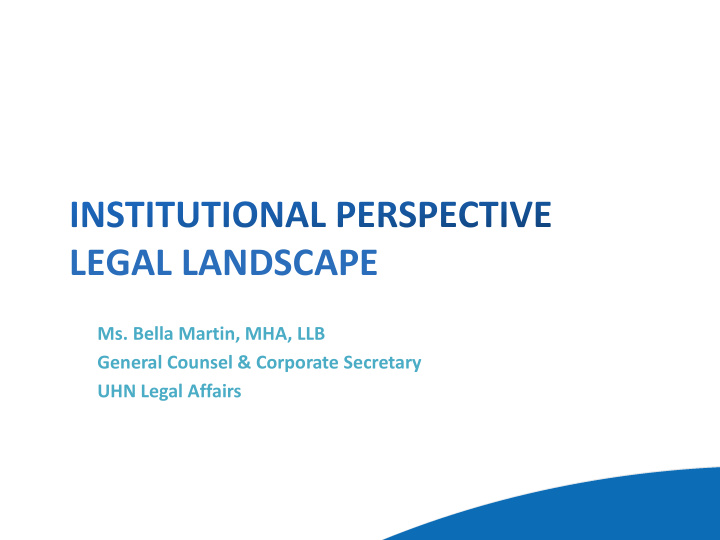



LEGAL LANDSCAPE Ms. Bella Martin, MHA, LLB General Counsel & Corporate Secretary UHN Legal Affairs
Legal Landscape Outline 1. Research Integrity 2. Natural Justice 3. Investigating Research Misconduct 4. Trends
What is Research Integrity? NIH Definition • use of honest and verifiable methods in proposing, performing, and evaluating research • reporting research results with attention to adherence to rules, regulations, guidelines • following commonly accepted professional codes or norms Honesty, Accuracy, Efficiency, Objectivity
Why does it Matter? UHN Responsible Conduct of Research Policy “Each member of the research community has a responsibility to foster intellectual honesty and integrity and to be vigilant regarding the conduct of research, whether his or her own or others. It is essential that research personnel maintain the highest standard of public trust and integrity.”
Responsibility for Research Integrity • To maintain public confidence in research, everyone has a role to play: • Researchers • Supervisors/Mentors • Administrators • Public (social media, blogs – e.g., PubPeer, Retraction Watch)
Natural Justice Basic premise in law: • Individuals should not be penalized by decisions affecting their rights unless they are afforded Natural Justice (e.g., due process, procedural fairness)
What is “Natural Justice”? 1. Rule against bias 2. Right to a fair hearing – Context dependent ( Baker v. Canada Immigration ) • Nature of decision • Statutory scheme under which decision-maker operates • Importance of decision to the person affected • Legitimate expectations of person affected
1. Rule Against Bias • Applies to anyone acting judicially or quasi- judicially • i.e., decision-making that affects individual rights • Should not act if decision-maker may be, or may reasonably be suspected to be, biased • Decision-maker must be impartial
2. Right to a Fair Hearing • Individual affected: • Has right to counsel • Must receive notice of hearing • Must be given particulars of case against them • Must be given fair opportunity to be heard and answer case against them • Must be given reasons for decision • Must have right of appeal
Investigating Allegations of Research Misconduct UHN “ Responsible Conduct of Research Policy ” • 2-Step process • Inquiry – allegations outlined • Unbiased Investigation Committee – Respondent has right to counsel – Respondent has right to be heard – Respondent receives draft reasons for decision with right to comment – Respondent receives final report of IC • Sanction decision by EVPs Research and Quality • Right of Appeal to CEO (final decision-maker)
Is CEO’s decision really final ? Judicially reviewable decisions … • Matters that are “ coloured with a public element, flavour or character sufficient to bring it within the purview of public law ”? • “ where a matter has a very serious, exceptional effect on the rights or interests of a broad segment of the public ” e.g., NO – Setia v. Appleby (2013) YES – SA v. UHN (2016)
Trends • Internet and social media – greater and more timely scrutiny of published material • Broader dissemination of information (e.g., Snowden) • Greater scrutiny of institutional decisions by Courts • Confidentiality concerns in FOI era – affects willingness of witnesses and/or investigators to participate in process • L oss of public confidence in the integrity of research
Recommend
More recommend